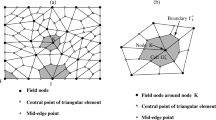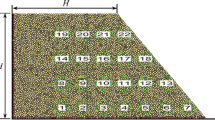Abstract
Failure of slopes is often hydrodynamic in nature. Most of the failures are due to water infiltration and movement in the matrix of an otherwise dry soil mass. Consideration of multi-phase aspect of soil behavior is appropriate for logical judgments that culminate in appropriate solutions for slope stability problems. The mesh-free Discrete Element Method has been employed for understanding soil behavior. Different particle sizes and packing have been considered for analysis. Force networks, strain deviators, kinetic energy evolution have been extracted and interpreted and their utility in slope failure prediction has been highlighted. Results show that suction has considerable influence on the behavior of soil at the micro-scale. The soil suction manifests in the form of additional cohesion resulting in arresting the deformations due to applied load as evidenced by the obtained strain deviator plots, thereby aiding in the stability of the soil mass. The changes and fluctuations in kinetic energy can be an indicator of system instability. The research helps to adopt a particle-level approach toward real-time monitoring of stability of unsaturated slopes.









Similar content being viewed by others
Data Availability
Not Applicable.
The authors declare that they have no conflict of interest. The authors have no competing interests to declare that are relevant to the content of this article.
References
Fredlund, D.G.: The 1999 RM Hardy Lecture: the implementation of unsaturated soil mechanics into geotechnical engineering. Can. Geotech. J. 37(5), 963–986 (2000). https://doi.org/10.1139/t00-026
Leshchinsky, B.; Vahedifard, F.; Koo, H.B.; Kim, S.H.: Yumokjeong Landslide: an investigation of progressive failure of a hillslope using the finite element method. Landslides 12(5), 997–1005 (2015). https://doi.org/10.1007/s10346-015-0610-5
Alonso, E.E.; Olivella, S.: Unsaturated soil mechanics applied to geotechnical problems. Unsaturated Soils 2006, 1–35 (2006). https://doi.org/10.1061/40802(189)1
Vanapalli, S.K.: Shear strength of unsaturated soils and its applications in geotechnical engineering practice. In: Buzzi, Fityus & Sheng (eds.) Unsaturated Soils, pp. 579–598. Taylor &Francis Group, London, (2010)
Tan, M.; Cheng, X.; Vanapalli, S.: Simple approaches for the design of shallow and deep foundations for unsaturated soils i: theoretical and experimental studies. Ind. Geotech. J. 51(1), 97–114 (2021). https://doi.org/10.1007/s40098-021-00501-2
Vanapalli, S.K.; Fredlund, D.G.; Pufahl, D.E.: The relationship between the soil-water characteristic curve and the unsaturated shear strength of a compacted glacial till. Geotech. Test. J. 19(3), 259–268 (1996). https://doi.org/10.1520/GTJ10351J
Farahnak, M.; Wan, R.; Pouragha, M.; Eghbalian, M.; Nicot, F.; Darve, F.: Micromechanical description of adsorptive-capillary stress in wet fine-grained media. Comput. Geotech. 137, 104047 (2021). https://doi.org/10.1016/j.compgeo.2021.104047
Liu, X.; Zhou, A.; Shen, S.L.; Li, J.; Arulrajah, A.: Modelling unsaturated soil-structure interfacial behavior by using DEM. Comput. Geotech. 137, 104305 (2021). https://doi.org/10.1016/j.compgeo.2021.104305
Fredlund, D.G.; Rahardjo, H.: Soil mechanics for unsaturated Soils. John Wiley & Sons, USA (1993)
Ghiyasabadi, S.F.; Habibagahi, G.; Nikooee, E.: A capillary water-retention framework for the effective stress parameter considering hydraulic hysteresis. Transp Porous Media 138(3), 489–509 (2021). https://doi.org/10.1007/s11242-021-01626-x
Zhai, Q.; Rahardjo, H.; Satyanaga, A.; Dai, G.: Estimation of unsaturated shear strength from soil–water characteristic curve. Acta Geotech. 14(6), 1977–1990 (2019). https://doi.org/10.1007/s11440-019-00785-y
Kristo, C.; Rahardjo, H.; Satyanaga, A.: Effect of hysteresis on the stability of residual soil slope. Int. Soil Water Conserv. Res. 7(3), 226–238 (2019). https://doi.org/10.1016/j.iswcr.2019.05.003
Rahardjo, H.; Kim, Y.; Satyanaga, A.: Role of unsaturated soil mechanics in geotechnical engineering. Int. J. Geo-Eng. 10(1), 1–23 (2019). https://doi.org/10.1186/s40703-019-0104-8
Cundall, P.A.; Strack, O.D.: A discrete numerical model for granular assemblies. Géotechnique 29(1), 47–65 (1979). https://doi.org/10.1680/geot.1979.29.1.47
Gingold, R.A.; Monaghan, J.J.: Smoothed particle hydrodynamics: theory and application to non-spherical stars. Mon. Not. R. Astron. Soc. 181(3), 375–389 (1977). https://doi.org/10.1093/mnras/181.3.375
Lucy, L.B.: A numerical approach to the testing of the fission hypothesis. Astron. J. 82, 1013–1024 (1977)
Sulsky, D.; Chen, Z.; Schreyer, H.L.: A particle method for history-dependent materials. Comput. Methods Appl. Mech. Eng. 118(1–2), 179–196 (1994). https://doi.org/10.1016/0045-7825(94)90112-0
Abe, K.; Soga, K.; Bandara, S.: Material point method for coupled hydromechanical problems. J. Geotech. Geoenviron. Eng. 140(3), 04013033 (2014). https://doi.org/10.1061/(ASCE)GT.1943-5606.0001011
Bandara, S.; Soga, K.: Coupling of soil deformation and pore fluid flow using material point method. Comput. Geotech. 63, 199–214 (2015). https://doi.org/10.1016/j.compgeo.2014.09.009
Donzé, F.V.; Richefeu, V.; Magnier, S.A.: Advances in discrete element method applied to soil, rock and concrete mechanics. Electron. J. Geotech. Eng. 8(1), 44 (2009)
Tong, A.T.; Catalano, E.; Chareyre, B.: Pore-scale flow simulations: model predictions compared with experiments on bi-dispersed granular assemblies. Oil Gas Sci. Technol-Revue d’IFP Energies nouvelles 67(5), 743–752 (2012). https://doi.org/10.2516/ogst/2012032
Gu, D.M.; Huang, D.; Liu, H.L.; Zhang, W.G.; Gao, X.C.: A DEM-based approach for modeling the evolution process of seepage-induced erosion in clayey sand. Acta Geotech. 14(6), 1629–1641 (2019). https://doi.org/10.1007/s11440-019-00848-0
Krzaczek, M.; Nitka, M.; Tejchman, J.: Effect of gas content in macropores on hydraulic fracturing in rocks using a fully coupled DEM/CFD approach. Int. J. Numer. Anal. Meth. Geomech. 45(2), 234–264 (2021). https://doi.org/10.1002/nag.3160
Guo, N.; Zhao, J.: A coupled FEM/DEM approach for hierarchical multiscale modelling of granular media. Int. J. Numer. Meth. Eng. 99(11), 789–818 (2014). https://doi.org/10.1002/nme.4702
Tran, V.D.H.; Meguid, M.A.; Chouinard, L.E.: A finite–discrete element framework for the 3D modeling of geogrid–soil interaction under pullout loading conditions. Geotext. Geomembr. 37, 1–9 (2013). https://doi.org/10.1016/j.geotexmem.2013.01.003
El Shamy, U.; Denissen, C.: Microscale characterization of energy dissipation mechanisms in liquefiable granular soils. Comput. Geotech. 37(7–8), 846–857 (2010). https://doi.org/10.1016/j.compgeo.2010.07.004
Dong, Y.; Fatahi, B.; Khabbaz, H.; Zhang, H.: Influence of particle contact models on soil response of poorly graded sand during cavity expansion in discrete element simulation. J. Rock Mech. Geotech. Eng. 10(6), 1154–1170 (2018). https://doi.org/10.1016/j.jrmge.2018.03.009
Meng, Q.X.; Wang, H.L.; Xu, W.Y.; Cai, M.; Xu, J.; Zhang, Q.: Multiscale strength reduction method for heterogeneous slope using hierarchical FEM/DEM modeling. Comput. Geotech. 115, 103164 (2019). https://doi.org/10.1016/j.compgeo.2019.103164
Nitka, M.; Tejchman, J.: Modelling of concrete behavior in uniaxial compression and tension with DEM. Granular Matter 17(1), 145–164 (2015). https://doi.org/10.1007/s10035-015-0546-4
Qu, T.; Feng, Y.T.; Wang, Y.; Wang, M.: Discrete element modelling of flexible membrane boundaries for triaxial tests. Comput. Geotech. 115, 103154 (2019). https://doi.org/10.1016/j.compgeo.2019.103154
Šmilauer, V. et al.: Yade Documentation 2nd ed. The Yade Project. http://yade-dem.org/doc/ (2015) Accessed 22 October 2021
Hertz, H.: Ueber die Beruhrung fester elastischer Korper. J. für die reine und angewandte Mathematik 92, 156–171 (1882)
Mindlin, R.D.: Compliance of elastic bodies in contact. J. Appl. Mech. 16(3), 259–268 (1949). https://doi.org/10.1115/1.4009973
Scholtès, L.; Chareyre, B.; Nicot, F.; Darve, F.: Micromechanics of granular materials with capillary effects. Int. J. Eng. Sci. 47(1), 64–75 (2009). https://doi.org/10.1016/j.ijengsci.2008.07.002
Cuomo, S.; Chareyre, B.; d’Arista, P.; Della Sala, M.; Cascini, L.: Micromechanical modelling of rainsplash erosion in unsaturated soils by Discrete Element Method. CATENA 147, 146–152 (2016). https://doi.org/10.1016/j.catena.2016.07.007
Yuan, C.; Chareyre, B.: A pore-scale method for hydromechanical coupling in deformable granular media. Comput. Methods Appl. Mech. Eng. 318, 1066–1079 (2017). https://doi.org/10.1016/j.cma.2017.02.024
Sorbino, G.; Nicotera, M.V.: Unsaturated soil mechanics in rainfall-induced flow landslides. Eng. Geol. 165, 105–132 (2013). https://doi.org/10.1016/j.enggeo.2012.10.008
Scholtès, L.; Hicher, P.Y.; Nicot, F.; Chareyre, B.; Darve, F.: On the capillary stress tensor in wet granular materials. Int. J. Numer. Anal. Meth. Geomech. 33(10), 1289–1313 (2009). https://doi.org/10.1002/nag.767
de Bono, J.P.; McDowell, G.R.: The fractal micro mechanics of normal compression. Comput. Geotech. 78, 11–24 (2016). https://doi.org/10.1016/j.compgeo.2016.04.018
Tordesillas, A.; Walker, D.M.; Lin, Q.: Force cycles and force chains. Phys. Rev. E 81(1), 011302 (2010). https://doi.org/10.1103/PhysRevE.81.011302
Kozicki, J.; Tejchman, J.; Mühlhaus, H.B.: Discrete simulations of a triaxial compression test for sand by DEM. Int. J. Numer. Anal. Meth. Geomech. 38(18), 1923–1952 (2014). https://doi.org/10.1002/nag.2285
Lobo-Guerrero, S., Vallejo, L. E.: DEM as an educational tool in geotechnical engineering. In: GeoCongress 2006: Geotechnical Engineering in the Information Technology Age pp. 1–6. (2006), https://doi.org/10.1061/40803(187)269
Liu, S.; Wang, J.; Kwok, C.Y.: DEM simulation of creep in one-dimensional compression of crushable sand. J. Geotech. Geoenviron. Eng. 145(10), 04019060 (2019). https://doi.org/10.1061/(ASCE)GT.1943-5606.0002098
Li, Z.; Wang, Y.H.; Chow, J.K.: Density effect and associated unjamming events on the aging-induced stiffness increase in sand. Int. J. Geomech. 18(12), 04018173 (2018). https://doi.org/10.1061/(ASCE)GM.1943-5622.0001320
Garcia, F.E.; Bray, J.D.: Distinct element simulations of shear rupture in dilatant granular media. Int. J. Geomech. 18(9), 04018111 (2018). https://doi.org/10.1061/(ASCE)GM.1943-5622.0001238
Shire, T.; O’Sullivan, C.; Hanley, K.J.: The influence of fines content and size-ratio on the micro-scale properties of dense bimodal materials. Granular Matter 18(3), 1–10 (2016). https://doi.org/10.1007/s10035-016-0654-9
Utili, S.; Zhao, T.; Houlsby, G.T.: 3D DEM investigation of granular column collapse: evaluation of debris motion and its destructive power. Eng. Geol. 186, 3–16 (2015). https://doi.org/10.1016/j.enggeo.2014.08.018
Zhang, N.; Evans, T.M.: Three dimensional discrete element method simulations of interface shear. Soils Found. 58(4), 941–956 (2018). https://doi.org/10.1016/j.sandf.2018.05.010
Abd, I.A.; Fattah, M.Y.; Mekkiyah, H.: Relationship between the matric suction and the shear strength in unsaturated soil. Case Studies Constr. Mater. 13, e00441 (2020). https://doi.org/10.1016/j.cscm.2020.e00441
Zhang, N.; Evans, T.M.: Discrete numerical simulations of torpedo anchor installation in granular soils. Comput. Geotech. 108, 40–52 (2019). https://doi.org/10.1016/j.compgeo.2018.12.013
Gili, J.A.; Alonso, E.E.: Microstructural deformation mechanisms of unsaturated granular soils. Int. J. Numer. Anal. Meth. Geomech. 26(5), 433–468 (2002). https://doi.org/10.1002/nag.206
Itasca Consulting Group, Inc. (2021) PFC — Particle Flow Code, Ver. 7.0. Minneapolis: Itasca.
Cho, G.C.; Santamarina, J.C.: Unsaturated particulate materials—particle-level studies. J. Geotech. Geoenviron. Eng. 127(1), 84–96 (2001). https://doi.org/10.1061/(ASCE)1090-0241(2001)127:1(84)
Tordesillas, A.; Muthuswamy, M.: On the modeling of confined buckling of force chains. J. Mech. Phys. Solids 57(4), 706–727 (2009). https://doi.org/10.1016/j.jmps.2009.01.005
Acknowledgements
Not Applicable
Funding
Not Applicable.
Author information
Authors and Affiliations
Contributions
All authors read and approved the final manuscript.
Corresponding author
Ethics declarations
Ethical approval and consent to participate
Not Applicable.
Consent for publication
Not Applicable.
Rights and permissions
Springer Nature or its licensor (e.g. a society or other partner) holds exclusive rights to this article under a publishing agreement with the author(s) or other rightsholder(s); author self-archiving of the accepted manuscript version of this article is solely governed by the terms of such publishing agreement and applicable law.
About this article
Cite this article
Shenoy, K.U., Narayan, K.S.B. & Sunil, B.M. Utilization of Discrete Element Method in Multi-phase Soil Modeling for Soil Slope Stability Analysis. Arab J Sci Eng 48, 5321–5333 (2023). https://doi.org/10.1007/s13369-022-07394-0
Received:
Accepted:
Published:
Issue Date:
DOI: https://doi.org/10.1007/s13369-022-07394-0




